Developing Functional Relationships between Soil Moisture Content and Corn Early-Season Physiology, Growth, and Development
Abstract
1. Introduction
2. Results
2.1. Physiological Parameters
2.2. Pigments
2.3. Plant Height, Number of Leaves, and Whole Plant Leaf Area
2.4. Biomass Parameters
2.5. Stress Tolerant Index
3. Discussion
4. Materials and Methods
4.1. Plant Materials and Growth Conditions
4.2. Soil Moisture Treatments
4.3. Data Collection
4.3.1. Physiological Parameters
4.3.2. Growth and Developmental Parameters
4.4. Statistical Analysis
5. Conclusions
Supplementary Materials
Author Contributions
Funding
Data Availability Statement
Acknowledgments
Conflicts of Interest
References
- Wang, J.; Hu, X. Research on corn production efficiency and influencing factors of typical farms: Based on data from 12 corn-producing countries from 2012 to 2019. PLoS ONE 2021, 16, e0254423. [Google Scholar] [CrossRef] [PubMed]
- FAOSTAT. Available online: https://www.fao.org/faostat/en/#data/QCL (accessed on 1 August 2022).
- Xu, T.; Guan, K.; Peng, B.; Wei, S.; Zhao, L. Machine learning-based modeling of spatio-temporally varying responses of rainfed corn yield to climate, soil, and management in the U.S. Corn Belt. Front. Artif. Intell. 2021, 4, 647999. [Google Scholar] [CrossRef] [PubMed]
- Hrozencik; USDA ERS—Irrigation & Water Use. Available online: https://www.ers.usda.gov/topics/farm-practices-management/irrigation-water-use/ (accessed on 26 October 2022).
- Lobell, D.B.; Deines, J.M.; Tommaso, S.D. Changes in the drought sensitivity of US maize yields. Nat. Food. 2020, 1, 729–735. [Google Scholar] [CrossRef] [PubMed]
- Barrett, J. Corn and Soybean Production up in 2021, USDA Reports Corn and Soybean Stocks up from Year Earlier, Winter Wheat Seedings up for 2022. Available online: https://www.nass.usda.gov/Newsroom/2022/01-12-2022.php (accessed on 28 August 2022).
- USDM. Available online: https://www.drought.gov/data-maps-tools/us-crops-and-livestock-drought (accessed on 29 August 2022).
- Chen, D.; Wang, S.; Cao, B.; Cao, D.; Leng, G.; Li, H.; Yin, L.; Shan, L.; Deng, X. Genotypic variation in growth and physiological response to drought stress and re-watering reveals the critical role of recovery in drought adaptation in maize seedlings. Front. Plant Sci. 2016, 6, 1241. [Google Scholar] [CrossRef] [PubMed]
- Anderson, B. Early Spring Drought Review for US Grain and Oilseed Crops. Available online: https://www.dtnpf.com/agriculture/web/ag/news/article/2022/03/23/early-spring-drought-review (accessed on 9 August 2022).
- Buckler, E.S.; Holland, J.B.; Bradbury, P.J.; Acharya, C.B.; Brown, P.J.; Browne, C.; Ersoz, E.; Flint-Garcia, S.; Garcia, A.; Glaubitz, J.C.; et al. The genetic architecture of maize flowering time. Science 2009, 325, 714–718. [Google Scholar] [CrossRef]
- Sah, R.P.; Chakraborty, M.; Prasad, K.; Pandit, M.; Tudu, V.K.; Chakravarty, M.K.; Narayan, S.C.; Rana, M.; Moharana, D. Impact of water deficit stress in maize: Phenology and yield components. Sci. Rep. 2020, 10, 2944. [Google Scholar] [CrossRef]
- Fahad, S.; Bajwa, A.A.; Nazir, U.; Anjum, S.A.; Farooq, A.; Zohaib, A.; Sadia, S.; Nasim, W.; Adkins, S.; Saud, S.; et al. Crop production under drought and heat stress: Plant responses and management options. Front. Plant Sci. 2017, 8, 1147. [Google Scholar] [CrossRef]
- Verslues, P.E.; Agarwal, M.; Katiyar-Agarwal, S.; Zhu, J.; Zhu, J.-K. Methods and concepts in quantifying resistance to drought, salt and freezing, abiotic stresses that affect plant water status. Plant J. 2006, 45, 523–539. [Google Scholar] [CrossRef]
- Rebolledo, M.-C.; Dingkuhn, M.; Clément-Vidal, A.; Rouan, L.; Luquet, D. phenomics of rice early vigour and drought response: Are sugar related and morphogenetic traits relevant? Rice 2012, 5, 22. [Google Scholar] [CrossRef]
- Walne, C.H.; Reddy, K.R. Temperature effects on the shoot and root growth, development, and biomass accumulation of corn (Zea Mays L.). Agriculture 2022, 12, 443. [Google Scholar] [CrossRef]
- Nguyen, G.N.; Norton, S.L.; Rosewarne, G.M.; James, L.E.; Slater, A.T. Automated phenotyping for early vigour of field pea seedlings in controlled environment by colour imaging technology. PLoS ONE 2018, 13, e0207788. [Google Scholar] [CrossRef]
- Vukasovic, S.; Alahmad, S.; Christopher, J.; Snowdon, R.J.; Stahl, A.; Hickey, L.T. Dissecting the genetics of early vigour to design drought-adapted wheat. Front. Plant Sci. 2022, 12, 754439. [Google Scholar] [CrossRef]
- Ramamoorthy, P.; Lakshmanan, K.; Upadhyaya, H.D.; Vadez, V.; Varshney, R.K. Root traits confer grain yield advantages under terminal drought in chickpea (Cicer arietinum L.). Field Crop. Res. 2017, 201, 146–161. [Google Scholar] [CrossRef]
- Yan, W.; Zhong, Y.; Shangguan, Z. A meta-analysis of leaf gas exchange and water status responses to drought. Sci. Rep. 2016, 6, 20917. [Google Scholar] [CrossRef]
- Ji, R.P.; Che, Y.S.; Zhu, Y.N.; Liang, T.; Feng, R.; Yu, W.Y.; Zhang, Y.S. Impacts of drought stress on the growth and development and grain yield of spring maize in northeast China. Ying Yong Sheng Tai Xue Bao 2012, 23, 3021–3026. [Google Scholar]
- Wang, Y.; Huang, Y.; Fu, W.; Guo, W.; Ren, N.; Zhao, Y.; Ye, Y. Efficient physiological and nutrient use efficiency responses of maize leaves to drought stress under different field nitrogen conditions. Agronomy 2020, 10, 523. [Google Scholar] [CrossRef]
- Rafique, S. Drought Responses on Physiological Attributes of Zea mays in Relation to Nitrogen and Source-Sink Relationships. In Abiotic Stress in Plants; IntechOpen: Rijeka, Croatia, 2020. [Google Scholar] [CrossRef]
- Anjum, S.A.; Wang, L.C.; Farooq, M.; Hussain, M.; Xue, L.L.; Zou, C.M. Brassinolide application improves the drought tolerance in maize through modulation of enzymatic antioxidants and leaf gas exchange. J. Agron. Crop Sci. 2011, 197, 177–185. [Google Scholar] [CrossRef]
- Hund, A.; Ruta, N.; Liedgens, M. Rooting depth and water use efficiency of tropical maize inbred lines, differing in drought tolerance. Plant Soil 2009, 318, 311–325. [Google Scholar] [CrossRef]
- Lopes, M.S.; Reynolds, M.P.; Lopes, M.S.; Reynolds, M.P. Partitioning of assimilates to deeper roots is associated with cooler canopies and increased yield under drought in wheat. Funct. Plant Biol. 2010, 37, 147–156. [Google Scholar] [CrossRef]
- Hassan, M.A.; Xiang, C.; Farooq, M.; Muhammad, N.; Yan, Z.; Hui, X.; Yuanyuan, K.; Bruno, A.K.; Lele, Z.; Jincai, L. Cold stress in wheat: Plant acclimation responses and management strategies. Front. Plant Sci. 2021, 12, 676884. [Google Scholar] [CrossRef]
- Giri, A.; Heckathorn, S.; Mishra, S.; Krause, C. Heat stress decreases levels of nutrient-uptake and -assimilation proteins in tomato roots. Plants 2017, 6, 6. [Google Scholar] [CrossRef]
- Tang, L.; Zhou, Q.S.; Gao, Y.; Li, P. Biomass allocation in response to salinity and competition in native and invasive species. Ecosphere 2022, 13, e3900. [Google Scholar] [CrossRef]
- Comas, L.; Becker, S.; Cruz, V.M.; Byrne, P.F.; Dierig, D.A. Root traits contributing to plant productivity under drought. Front. Plant Sci. 2013, 4, 442. [Google Scholar] [CrossRef]
- Van Dooren, T.J.M.; Silveira, A.B.; Gilbault, E.; Jiménez-Gómez, J.M.; Martin, A.; Bach, L.; Tisné, S.; Quadrana, L.; Loudet, O.; Colot, V. Mild drought in the vegetative stage induces phenotypic, gene expression, and DNA methylation plasticity in arabidopsis but no transgenerational effects. J. Exp. Bot. 2020, 71, 3588–3602. [Google Scholar] [CrossRef]
- Lopes, M.S.; Araus, J.L.; van Heerden, P.D.R.; Foyer, C.H. Enhancing drought tolerance in C4 Crops. J. Exp. Bot. 2011, 62, 3135–3153. [Google Scholar] [CrossRef]
- Avramova, V.; Nagel, K.A.; AbdElgawad, H.; Bustos, D.; DuPlessis, M.; Fiorani, F.; Beemster, G.T.S. Screening for drought tolerance of maize hybrids by multi-scale analysis of root and shoot traits at the seedling stage. J. Exp. Bot. 2016, 67, 2453–2466. [Google Scholar] [CrossRef]
- Moreira, S.A.F.; Alves, P.F.S.; Corsato, C.E.; Azevedo, A.M. Maize Hybrids contrasting for drought tolerance differ during the vegetative stage. Semina Ciências Agrárias 2020, 41, 1093–1106. [Google Scholar] [CrossRef]
- Avramova, V.; AbdElgawad, H.; Zhang, Z.; Fotschki, B.; Casadevall, R.; Vergauwen, L.; Knapen, D.; Taleisnik, E.; Guisez, Y.; Asard, H.; et al. drought induces distinct growth response, protection, and recovery mechanisms in the maize leaf growth zone. Plant Physiol. 2015, 169, 1382–1396. [Google Scholar] [CrossRef]
- Lichtenthaler, H.K. The stress concept in plants: An introduction. Ann. N. Y. Acad. Sci. 1998, 851, 187–198. [Google Scholar] [CrossRef]
- Flexas, J.; Ribas-Carbó, M.; Bota, J.; Galmés, J.; Henkle, M.; Martínez-Cañellas, S.; Medrano, H. Decreased rubisco activity during water stress is not induced by decreased relative water content but related to conditions of low stomatal conductance and chloroplast CO2 concentration. New Phytol. 2006, 172, 73–82. [Google Scholar] [CrossRef]
- Gajanayake, B.; Reddy, K.R.; Shankle, M.W.; Arancibia, R.A. Early-season soil moisture deficit reduces sweetpotato storage root initiation and development. HortScience 2013, 48, 1457–1462. [Google Scholar] [CrossRef]
- Tsuji, W.; Ali, M.E.K.; Inanaga, S.; Sugimoto, Y. Growth and gas exchange of three sorghum cultivars under drought stress. Biol. Plant. 2003, 46, 583–587. [Google Scholar] [CrossRef]
- Erdal, Ş.; Pamukçu, M.; Öztürk, A.; Aydinsakir, K.; Ozlem, Y.D. Morpho-physiological combining ability among tropical and temperate maize germplasm for drought tolerance. Genetika 2016, 48, 1053–1066. [Google Scholar] [CrossRef]
- Song, H.; Li, Y.; Zhou, L.; Xu, Z.; Zhou, G. Maize leaf functional responses to drought episode and rewatering. Agric. For. Meteorol. 2018, 249, 57–70. [Google Scholar] [CrossRef]
- Ahmed, C.B.; Rouina, B.B.; Sensoy, S.; Boukhris, M.; Abdallah, F.B. Changes in gas exchange, proline accumulation and antioxidative enzyme activities in three olive cultivars under contrasting water availability regimes. Environ. Exp. Bot. 2009, 67, 345–352. [Google Scholar] [CrossRef]
- Liu, W.J.; Liu, H.; Chen, Y.E.; Yin, Y.; Zhang, Z.W.; Song, J.; Chang, L.J.; Zhang, F.L.; Wang, D.; Dai, X.H.; et al. Chloroplastic photoprotective strategies differ between bundle sheath and mesophyll cells in maize (Zea mays L.) under drought. Front. Plant Sci. 2022, 13, 885781. [Google Scholar] [CrossRef]
- Nakabayashi, R.; Yonekura-Sakakibara, K.; Urano, K.; Suzuki, M.; Yamada, Y.; Nishizawa, T.; Matsuda, F.; Kojima, M.; Sakakibara, H.; Shinozaki, K.; et al. Enhancement of oxidative and drought tolerance in arabidopsis by overaccumulation of antioxidant flavonoids. Plant J. 2014, 77, 367–379. [Google Scholar] [CrossRef]
- Bashir, N.; Athar, H.-R.; Kalaji, H.M.; Wróbel, J.; Mahmood, S.; Zafar, Z.U.; Ashraf, M. Is photoprotection of psii one of the key mechanisms for drought tolerance in maize? Int. J. Mol. Sci. 2021, 22, 13490. [Google Scholar] [CrossRef]
- Evans, J.R. Improving photosynthesis. Plant Physiol. 2013, 162, 1780–1793. [Google Scholar] [CrossRef]
- Xu, Z.; Zhou, G. Responses of leaf stomatal density to water status and its relationship with photosynthesis in a grass. J. Exp. Bot. 2008, 59, 3317–3325. [Google Scholar] [CrossRef]
- Xu, Z.; Zhou, G.; Shimizu, H. Plant responses to drought and rewatering. Plant Signal Behav. 2010, 5, 649–654. [Google Scholar] [CrossRef]
- Hammer, G.L.; Dong, Z.; McLean, G.; Doherty, A.; Messina, C.; Schussler, J.; Zinselmeier, C.; Paszkiewicz, S.; Cooper, M. Can changes in canopy and/or root system architecture explain historical maize yield trends in the U.S. Corn Belt? Crop Sci. 2009, 49, 299–312. [Google Scholar] [CrossRef]
- Lone, A.A.; Jumaa, S.H.; Wijewardana, C.; Taduri, S.; Redona, E.D.; Reddy, K.R. Drought stress tolerance screening of elite American breeding rice genotypes using low-cost pre-fabricated mini-hoop modules. Agronomy 2019, 9, 199. [Google Scholar] [CrossRef]
- Hewitt Sand and water culture methods used in the study of plant nutrition. Soil Sci. Soc. Am. J. 1953, 17, 301. [CrossRef]
- USDM, U.S. Drought Monitor. Available online: https://droughtmonitor.unl.edu/About/WhatistheUSDM.aspx (accessed on 5 February 2023).
- R Core Team. R: A Language and Environment for Statistical Computing; R foundation for statistical computing: Vienna, Austria, 2022. [Google Scholar]
- Fernandez, G.C.J. Effective selection criteria for assessing plant stress tolerance. In Proceedings of the International Symposium on Adaptation of Food Crops to Temperature and Water Stress, Taiwan, China, 13–18 August 1992. [Google Scholar] [CrossRef]
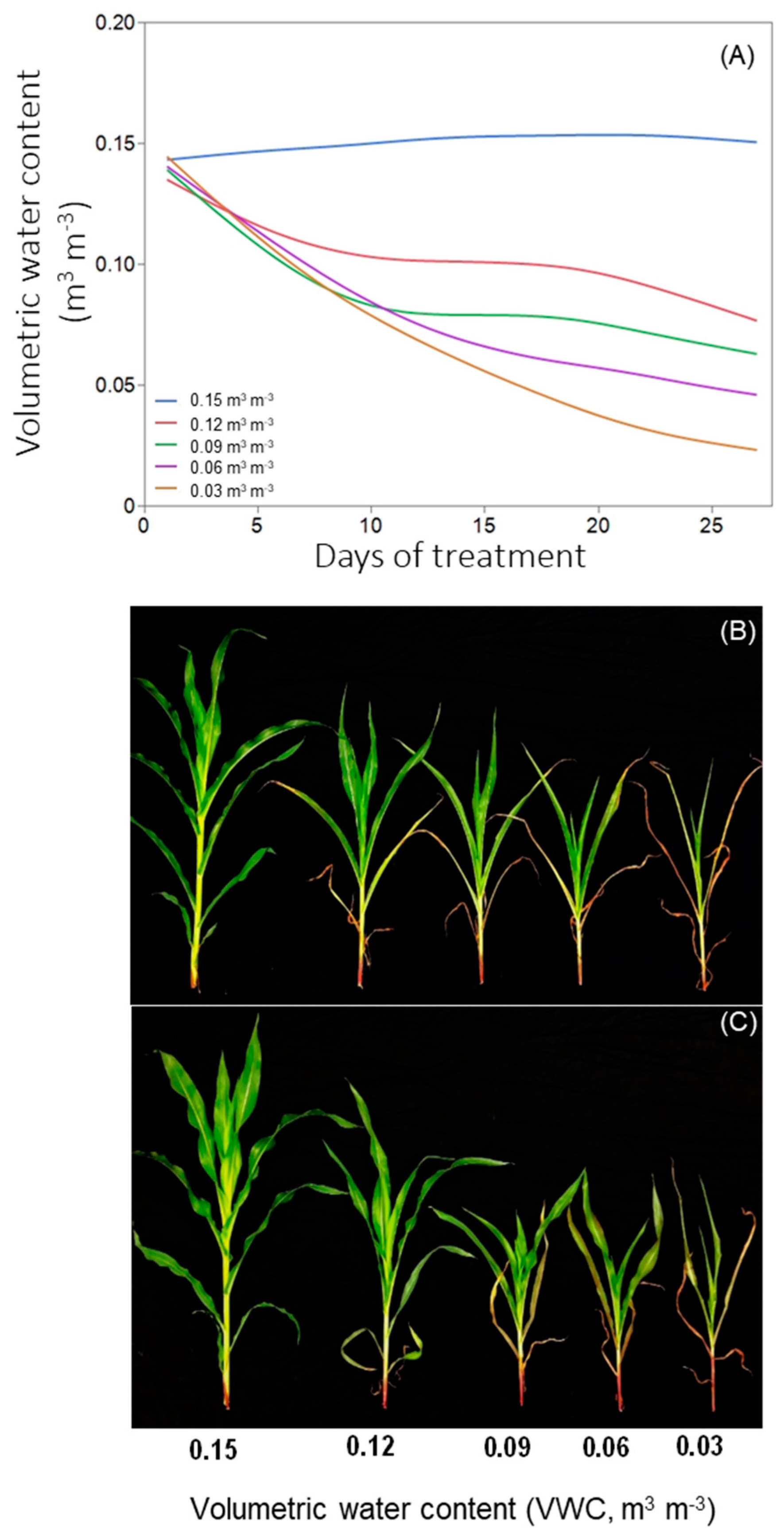
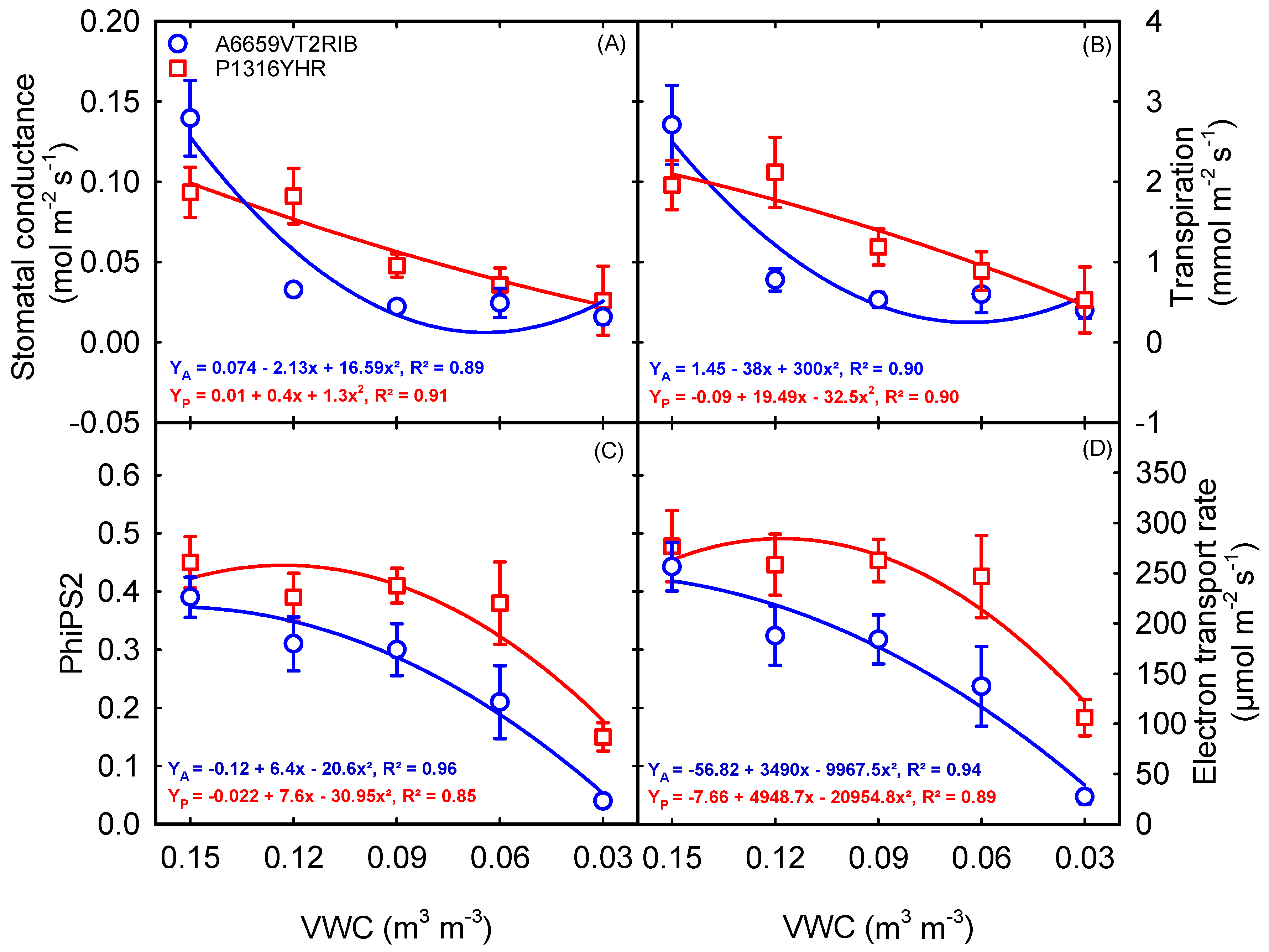
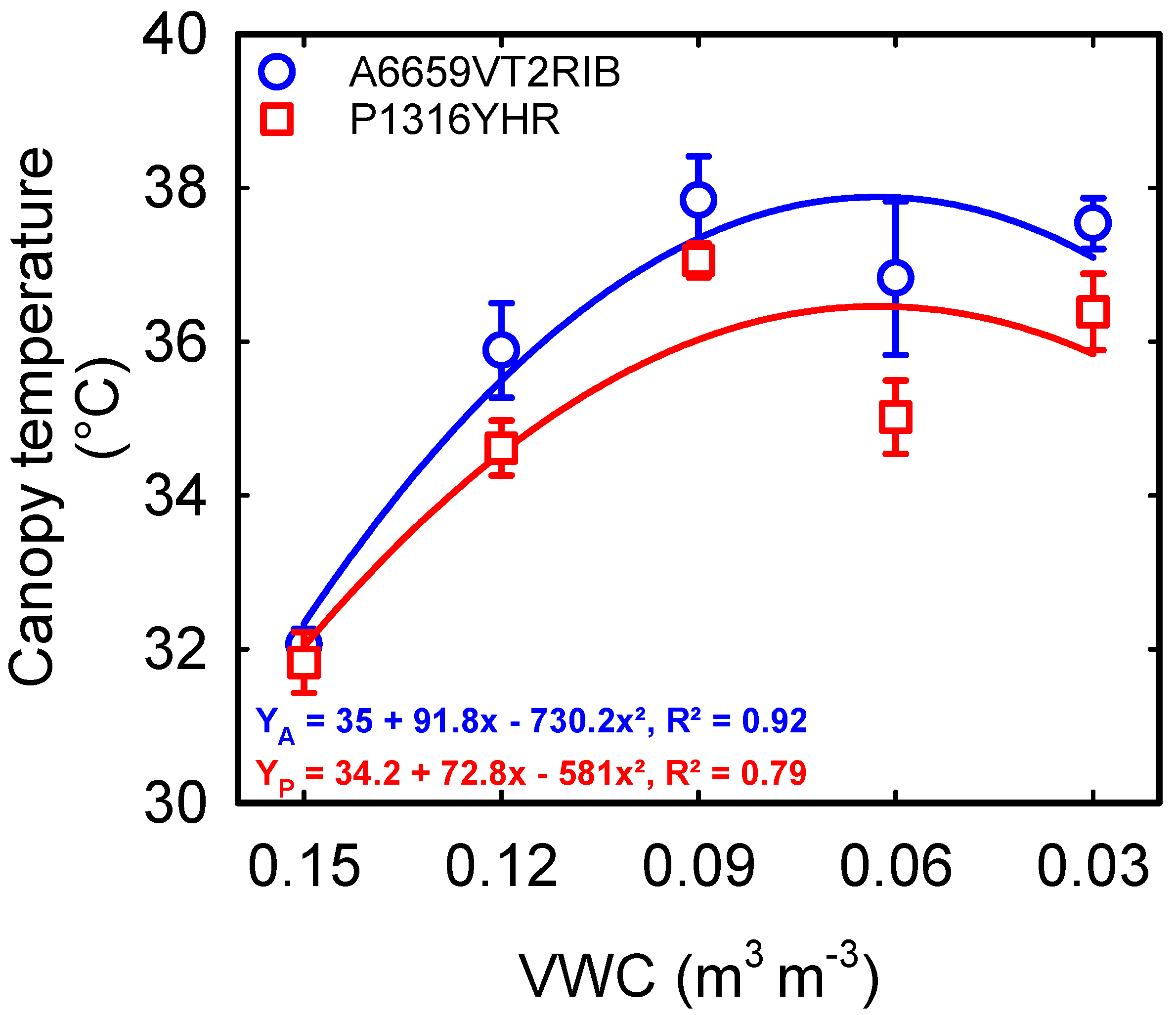
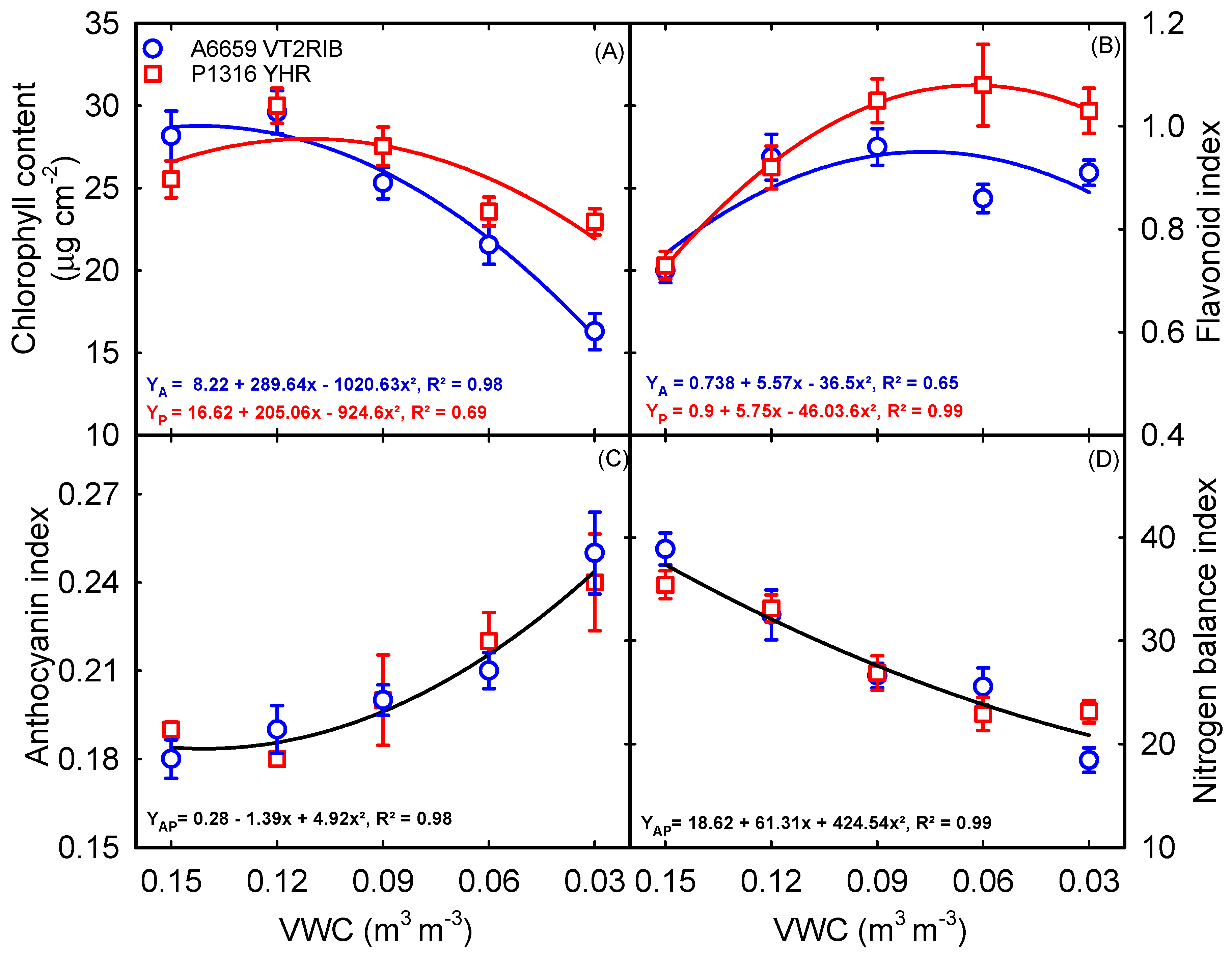
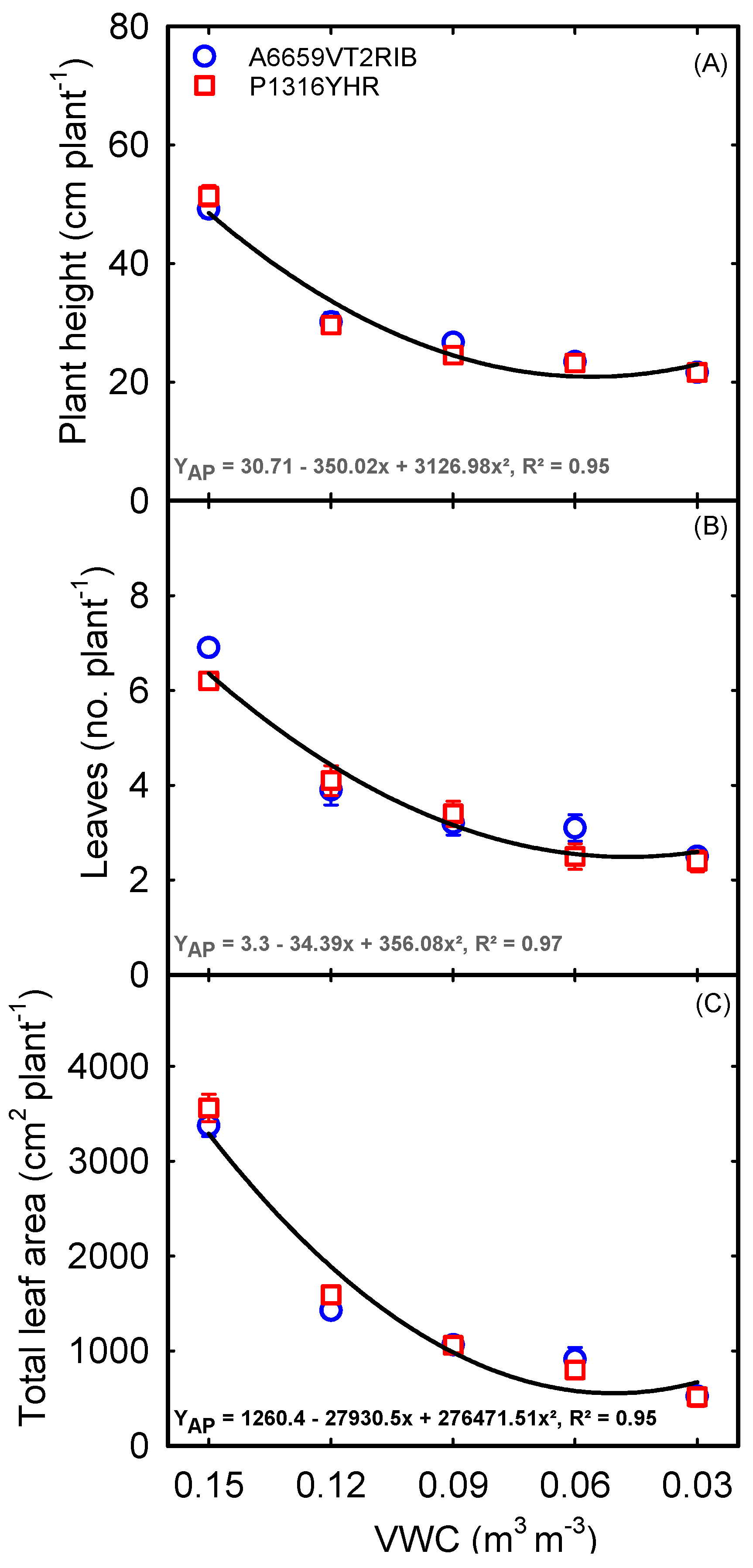
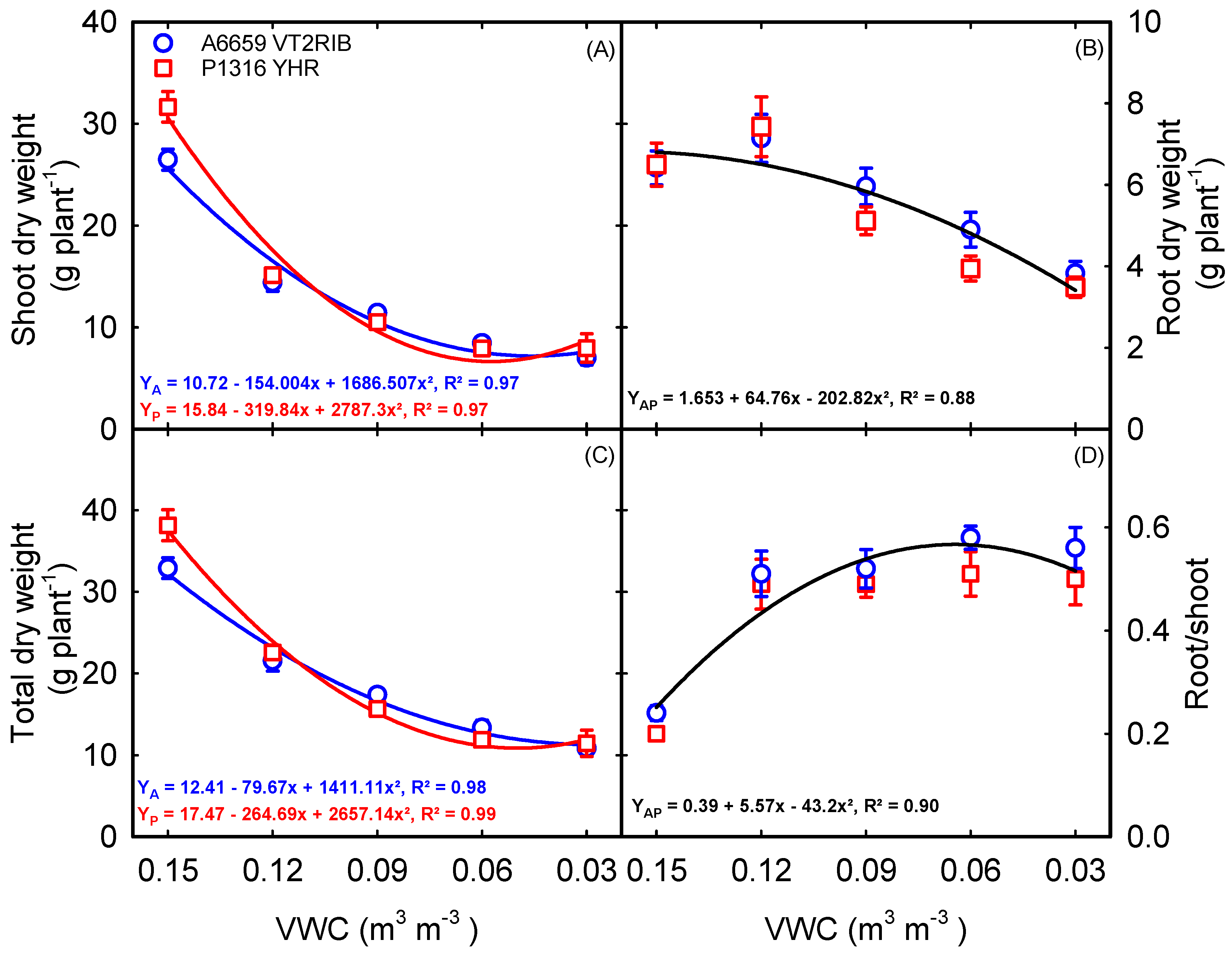
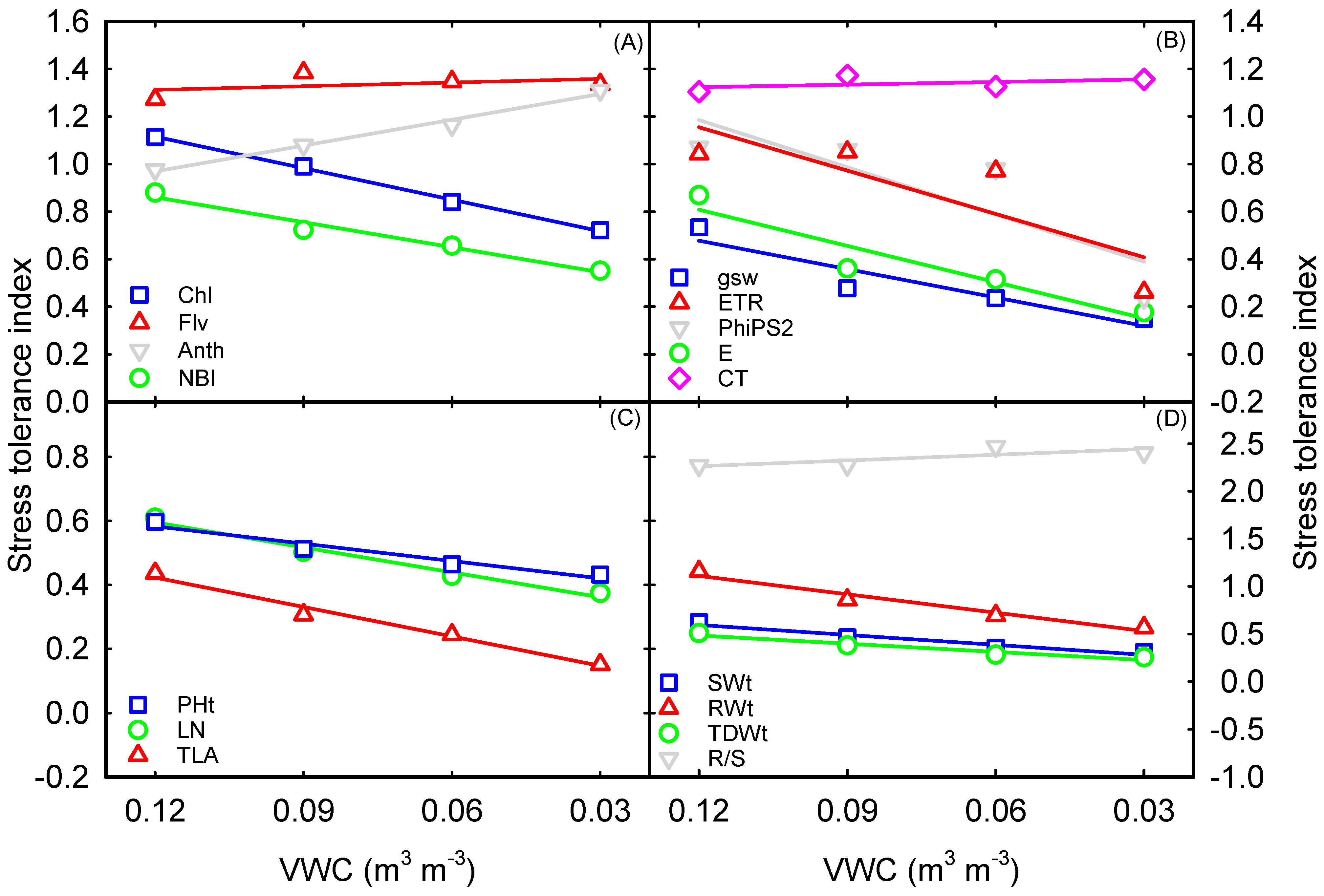
| Source | gsw | E | ETR | PhiPS2 | CT | Chl | Flv | Anth | NBI | PHt | TLA | LN | SWt | RWt | TDWt | R/S |
|---|---|---|---|---|---|---|---|---|---|---|---|---|---|---|---|---|
| Hybrid (H) | ns | ns | *** | *** | ** | * | ** | ns | ns | ns | ns | ns | ns | ns | ns | ns |
| Treatment (T) | *** | *** | *** | *** | *** | *** | *** | *** | *** | *** | *** | *** | *** | *** | *** | *** |
| H × T | * | * | ns | ns | ns | ** | * | ns | ns | ns | ns | ns | ** | ns | * | ns |
Disclaimer/Publisher’s Note: The statements, opinions and data contained in all publications are solely those of the individual author(s) and contributor(s) and not of MDPI and/or the editor(s). MDPI and/or the editor(s) disclaim responsibility for any injury to people or property resulting from any ideas, methods, instructions or products referred to in the content. |
© 2023 by the authors. Licensee MDPI, Basel, Switzerland. This article is an open access article distributed under the terms and conditions of the Creative Commons Attribution (CC BY) license (https://creativecommons.org/licenses/by/4.0/).
Share and Cite
Vennam, R.R.; Ramamoorthy, P.; Poudel, S.; Reddy, K.R.; Henry, W.B.; Bheemanahalli, R. Developing Functional Relationships between Soil Moisture Content and Corn Early-Season Physiology, Growth, and Development. Plants 2023, 12, 2471. https://doi.org/10.3390/plants12132471
Vennam RR, Ramamoorthy P, Poudel S, Reddy KR, Henry WB, Bheemanahalli R. Developing Functional Relationships between Soil Moisture Content and Corn Early-Season Physiology, Growth, and Development. Plants. 2023; 12(13):2471. https://doi.org/10.3390/plants12132471
Chicago/Turabian StyleVennam, Ranadheer Reddy, Purushothaman Ramamoorthy, Sadikshya Poudel, Kambham Raja Reddy, William Brien Henry, and Raju Bheemanahalli. 2023. "Developing Functional Relationships between Soil Moisture Content and Corn Early-Season Physiology, Growth, and Development" Plants 12, no. 13: 2471. https://doi.org/10.3390/plants12132471
APA StyleVennam, R. R., Ramamoorthy, P., Poudel, S., Reddy, K. R., Henry, W. B., & Bheemanahalli, R. (2023). Developing Functional Relationships between Soil Moisture Content and Corn Early-Season Physiology, Growth, and Development. Plants, 12(13), 2471. https://doi.org/10.3390/plants12132471







